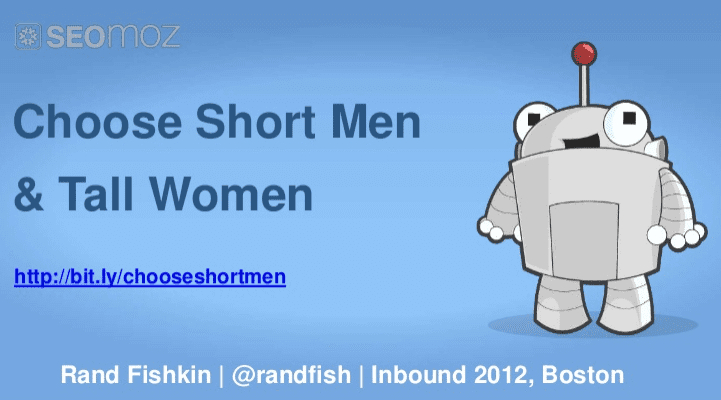Two weeks ago I, along with 2,800 other marketers, attended Inbound 2012 (an inbound marketing conference) in Boston. It was a fantastic week with 5 great keynotes by people such as David Meerman Scott and Gary Vaynerchuck. This post will cover the fantastic keynote by Rand Fishkin, CEO of SEOMoz. His talk ‘Choose Short Men & Tall Women’ highlighted how irrational biases can prevent us from accessing a world of opportunity, in this case in
Rand started by demonstrating how in the online dating world the bias against short men results in people missing out big in other areas. For example, if you left the height requirement field empty you could choose from profiles with 4+ star average reviews, with photos, with a 3rd level education, who have answered at least 25 of the online profiling questions etc.
Related: Why SEO Is Not Optional – A Back To Basics Guide
Basically one irrational bias can hold you back big time.
Rand then went through 12 irrational
12 Irrational SEO Biases
Bias 1: Ranking Position Is All That Matters
- Click Through Rate (CTR) is influenced by more than just ranking position nowadays, as rich search results (snippets) often include images and video links which can affect CTRs.
- Domain name also has a big affect on CTR.
Bias 2: Active Link Building Is Required For SEO
- The best links build themselves.
- You should focus on building relationships, and the links will build themselves.
Bias 3: ‘There Can Be Only One’ (Topic)
- Don’t fall into the trap of thinking “I should only talk about my specific topic” … focus on your audience’s interests, not a narrow subject e.g. topics which are:
- Relevant to potential customers;
- Relevant to current customers; or
- Relevant to anyone who interacts with potential customers.
- Broad topics earn signals that help your entire site … links to other pages on your website (and not just the homepage) raises the authority of the whole domain.
Bias 4: Twitter & Facebook Are The Only Networks That Matter
- This bias is a result of press coverage that only mentions these two networks.
- There are many other networks … often you can have less followers but more traction on other sites.
Bias 5: If A Viral Content Effort Fails … It’s Over!
- Try something, but if you fail it’s not the end of the world!
- Content can be repackaged and reoptimised and often might not hit gold until the 2nd or 3rd time out.
- Just because it fails the first time doesn’t mean it can’t be tried again.
- Viral is going to fail 9 out of 10 times. Plan for it. Try try again!
- If no one sees it, no one will care if you tweak it next time.
Bias 6: Only Target High-Search Volume Keywords
- Long tail keywords are amazing.
- 1/5th of searches have never been searched before.
- Google’s ‘Search Suggest’ is a great keyword research tool – start searching in Google to see what auto-complete words pop up.
- Google news is also a great place to find undiscovered keywords and topics that haven’t hit the mainstream yet.
Related: Davey Potter And The Magic SEO Wand
Bias 7: My Site Is The Only Place To Do SEO
- YouTube – video
SEO rocks! - Slideshare: keywords and embeds = ranking magic.
- Quora, Linkedin and news sites are also all great options.
Bias 8: Social Sharing Is A Fire & Forget Tactic
- Timing matters … the 3.5% of people online at night are almost certainly not the same as the 6.7% online in the morning. Publish to social networks multiple times to hit different audiences.
- Link placement matters … in tweets when the url is placed in the middle of the tweet, instead of at the end beside a hashtag, it gets more clicks.
- Using an event hashtag will get your tweet in front of the right people.
- Mentioning a high profile person e.g. @randfish in your tweet makes sure that person sees it, which means they might retweet it.
- Snippets (the preview panel with image and description linking to your page) matter in Google+ (and affect Google) so make sure images and descriptions look well.
Bias 9: Engines Prefer Text Content
- Many forms of content work well.
- “Creative content kicks butt!”
Bias 10: I Should Chase My Competitors’ Links
- Research links that point to non-competitive sites in your niche and cultivate these.
- Focus beyond the keywords and sites you’re chasing, to those who may have topical overlap.
Bias 11: Spending Money For Links Is ‘Black Hat’
- Most of the time ‘buying links’ is spammy and Google will come after you for it.
- However event participation costs money and earns links, as do job ads, acquisitions, sponsoring research and any other press worthy news.
Bias 12: There’s No Simple Way To Increase Traffic
- Site speed optimisation is a simple fix which increases traffic – a small increase in speed can result in not only more traffic, but also in Google crawling / indexing more pages on your website.
- 404, 500 & 302 fixes are all simple and increase traffic – see Google and Bing webmaster tools.
- Retargeting is also simple and increases traffic as prospects who have visited your site then see your ads on other sites, which reminds them to return to your site.
Takeaway message … removing your irrational bias will result in big wins. This thinking does not just apply to
See Rand’s full slide deck for the above presentation.


